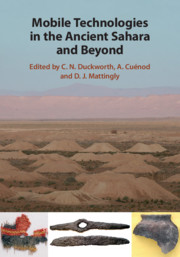Book contents
- Mobile Technologies in the Ancient Sahara and Beyond
- The Trans-Saharan Archaeology Series
- Mobile Technologies in the Ancient Sahara and Beyond
- Copyright page
- Contents
- Figures
- Tables
- Contributors
- Preface
- Part I Introduction
- Part II Technological Mobility and Transfers
- Part III Metallurgy
- Part IV Glass Technology
- 10 Shattering Illusions
- 11 Glass Beads in African Society
- 12 Three Millennia of Egyptian Glassmaking
- Part V Handmade Pottery
- Part VI Conclusion
- Index
- References
12 - Three Millennia of Egyptian Glassmaking
from Part IV - Glass Technology
Published online by Cambridge University Press: 18 September 2020
- Mobile Technologies in the Ancient Sahara and Beyond
- The Trans-Saharan Archaeology Series
- Mobile Technologies in the Ancient Sahara and Beyond
- Copyright page
- Contents
- Figures
- Tables
- Contributors
- Preface
- Part I Introduction
- Part II Technological Mobility and Transfers
- Part III Metallurgy
- Part IV Glass Technology
- 10 Shattering Illusions
- 11 Glass Beads in African Society
- 12 Three Millennia of Egyptian Glassmaking
- Part V Handmade Pottery
- Part VI Conclusion
- Index
- References
Summary
This chapter covers nearly three millennia of glassmaking in Egypt, from the beginning of the Late Bronze Age at around 1500 BC up to the beginning of the second millennium AD. This period saw several major changes in the material composition as well as the social meaning of glass, illustrated in our overview by case studies done on glass from Egypt. For much of the Late Bronze Age, and again during the first millennium AD, there is a very significant sea-borne flow of glass from Egypt to the north, providing much of Europe with glass. In contrast, we argue that there is relatively little material interaction and exchange of glass with the Levant to the east, a region which had its own large glass production centres for much of this period. We hope that by looking west and south we can see whether there was a stronger integration of Egypt and its glass industry as part of a wider land-based exchange network. For convenience, the chapter covers the evidence separately for primary glass making and for glass use, respectively, and within these two sections we structure it by broad blocks of time.
- Type
- Chapter
- Information
- Mobile Technologies in the Ancient Sahara and Beyond , pp. 423 - 450Publisher: Cambridge University PressPrint publication year: 2020
References
- 3
- Cited by



